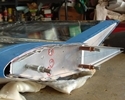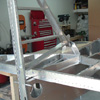


random user submitted photo
Safety Concerns
21 posts
• Page 3 of 3 • 1, 2, 3
Re: Safety Concerns
My biggest safety concern is the powerplant(s). The reason for that concern is most of the accident investigations I've read don't determine what caused it to stop, see no reason for the stoppage, or even which engine was installed for that matter. The variation of installations and equipment you can have under the cowl is just too great for the amount of effort (or lack there of) they put into these investigations. 90% of the time an NTSB agent never went to the crash site. They tend to only go to the high profile accidents. Our accidents are likely investigated by an FAA investigator who has a different end mission than the NTSB. For my own curiosity, I'd like to see an equipment list from the aircraft that crashed for no apparent reason. Mostly to determine if there are any common threads (Aerocarb, certain avionics, throttle quad, ignition system). An engine out I can handle. You're chances of survival are high if you do the right thing. Be prepared!
Sonex has it where it counts in my opinion. The airframe is robust and the handling characteristics are fantastic. Everything I would want in a plane. My two biggest mechanical fears while flying are structural failure and fire. Both of which will kill you faster than anything. Neither are of much concern in the history of Sonex accidents I've read.
Most of the reports I've read can be written off as pilot error or some anomaly. The two accidents that haunt me are N732SX and N123SX. N732SX was simply an attempt at the impossible turn. What bothers me was the pilot was an ATP with tons of experience. He should have known better but he tried it anyway. It's either an example of overconfidence or the overwhelming desire to get back to the runway. I tend to believe it's the latter. The jury is out on N123SX and I don't want to speculate. Based on the preliminary investigation, however, it looks like Jeremy was trying to get back to the airport as well.
So what do I take away from this?
1: The Sonex is a safe airframe.
2: Be ready for that engine out situation. Do your best to mitigate the dangers in case your engine quits.
3: You absolutely, positively, undoubtedly, MUST fight the urge that a runway is the only safe place to land.
Two personal experiences have made me think about #2 & #3 constantly.
The first was scud running over the GA/NC/TN mountains on my way home from OSH one year. I was with my friend in his Tampico and we were still legal VFR but just barely. I remember looking out the window at the ridges and rocky streams thinking "If we lose our engine here we're dead." We made it home without incident. Seven hours later that engine ate a valve (O-360) and my friend totaled the plane by landing in a small field. He was uninjured but he didn't make the airport or even his first landing spot. He was on plan "C" when he landed. He had less than 150 hours as a Private Pilot at the time. If that valve had let go eight flight hours earlier, I doubt I'd be typing this right now.
Second was the on my last BFR in the 170. I had a simulated engine out. I picked a nice looking grassy field and pointed my plane at it. My instructor asked me why I wasn't headed to the nearby airport which is what he wanted and expected. I told him I wasn't SURE I could make it but I was positive I could put it down in the grassy field. We headed to the runway as a test of the glide capabilities of the old Cessna and we made the runway....barely. While I enjoyed testing the plane, I realize the actual experience may be detrimental to my thought process in an actual emergency. Ironically, testing the plane to it's limits in the glide might encourage me to do so when I shouldn't. Sometimes experience can be your enemy. I've seen real life examples of it many times at work.
As to flying a Sonex. I did my transition training with Joe. The only thing that was difficult to reach in the factory Waiex was the fuel valve. Joe had that problem licked. He simply would use his toe to turn it on and off. I imagine this would work for any average sized or smaller guy but the tall folks would have a problem because they probably don't have enough room under the panel to move without bashing their knees. Neither the brakes nor the flap handle or any other controls were difficult to reach for me in the Waiex. I'm used to mechanical (man powered) flaps. It was what my 170 had. In a way they are much more effective. I can deploy them or retract them as slow or fast as my muscles will allow. My plane has a hydraulic brake on the stick. It does OK at stopping the plane but will barely hold it for the run-up. Reaching the fuel valve is a non-issue for me because the shoulder belts in #600 are tension reels. I simply lean slowly forward and I'm fine. What does concern me after reading this thread is the thought that a sudden stop could open the fuel valve. Since you pull it to the rear and at a right angle (parallel to the wing), it occurs to me it could get thrown forward and open up if the impact was strong enough. I will put some thought into that issue before my next annual and see if that's something I want to fix.
My synopsis: The Sonex is safe. The only question mark may be the engine(s) but that is the same question mark for every single engine aircraft out there and why we train from day one for engine failures. In that respect, I don't think my Sonex is any less safe than my 68 year old Cessna.
Sonex has it where it counts in my opinion. The airframe is robust and the handling characteristics are fantastic. Everything I would want in a plane. My two biggest mechanical fears while flying are structural failure and fire. Both of which will kill you faster than anything. Neither are of much concern in the history of Sonex accidents I've read.
Most of the reports I've read can be written off as pilot error or some anomaly. The two accidents that haunt me are N732SX and N123SX. N732SX was simply an attempt at the impossible turn. What bothers me was the pilot was an ATP with tons of experience. He should have known better but he tried it anyway. It's either an example of overconfidence or the overwhelming desire to get back to the runway. I tend to believe it's the latter. The jury is out on N123SX and I don't want to speculate. Based on the preliminary investigation, however, it looks like Jeremy was trying to get back to the airport as well.
So what do I take away from this?
1: The Sonex is a safe airframe.
2: Be ready for that engine out situation. Do your best to mitigate the dangers in case your engine quits.
3: You absolutely, positively, undoubtedly, MUST fight the urge that a runway is the only safe place to land.
Two personal experiences have made me think about #2 & #3 constantly.
The first was scud running over the GA/NC/TN mountains on my way home from OSH one year. I was with my friend in his Tampico and we were still legal VFR but just barely. I remember looking out the window at the ridges and rocky streams thinking "If we lose our engine here we're dead." We made it home without incident. Seven hours later that engine ate a valve (O-360) and my friend totaled the plane by landing in a small field. He was uninjured but he didn't make the airport or even his first landing spot. He was on plan "C" when he landed. He had less than 150 hours as a Private Pilot at the time. If that valve had let go eight flight hours earlier, I doubt I'd be typing this right now.
Second was the on my last BFR in the 170. I had a simulated engine out. I picked a nice looking grassy field and pointed my plane at it. My instructor asked me why I wasn't headed to the nearby airport which is what he wanted and expected. I told him I wasn't SURE I could make it but I was positive I could put it down in the grassy field. We headed to the runway as a test of the glide capabilities of the old Cessna and we made the runway....barely. While I enjoyed testing the plane, I realize the actual experience may be detrimental to my thought process in an actual emergency. Ironically, testing the plane to it's limits in the glide might encourage me to do so when I shouldn't. Sometimes experience can be your enemy. I've seen real life examples of it many times at work.
As to flying a Sonex. I did my transition training with Joe. The only thing that was difficult to reach in the factory Waiex was the fuel valve. Joe had that problem licked. He simply would use his toe to turn it on and off. I imagine this would work for any average sized or smaller guy but the tall folks would have a problem because they probably don't have enough room under the panel to move without bashing their knees. Neither the brakes nor the flap handle or any other controls were difficult to reach for me in the Waiex. I'm used to mechanical (man powered) flaps. It was what my 170 had. In a way they are much more effective. I can deploy them or retract them as slow or fast as my muscles will allow. My plane has a hydraulic brake on the stick. It does OK at stopping the plane but will barely hold it for the run-up. Reaching the fuel valve is a non-issue for me because the shoulder belts in #600 are tension reels. I simply lean slowly forward and I'm fine. What does concern me after reading this thread is the thought that a sudden stop could open the fuel valve. Since you pull it to the rear and at a right angle (parallel to the wing), it occurs to me it could get thrown forward and open up if the impact was strong enough. I will put some thought into that issue before my next annual and see if that's something I want to fix.
My synopsis: The Sonex is safe. The only question mark may be the engine(s) but that is the same question mark for every single engine aircraft out there and why we train from day one for engine failures. In that respect, I don't think my Sonex is any less safe than my 68 year old Cessna.
Glenn
Sonex #600
N889AP
Sonex #600
N889AP
- vwglenn
- Posts: 416
- Joined: Mon Sep 15, 2014 1:00 am
- Location: 6A2 - South of ATL
21 posts
• Page 3 of 3 • 1, 2, 3
Who is online
Users browsing this forum: No registered users and 73 guests







